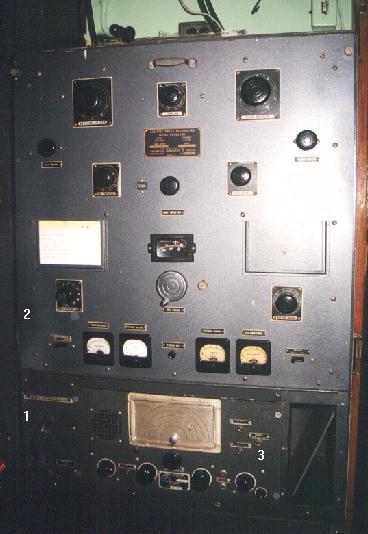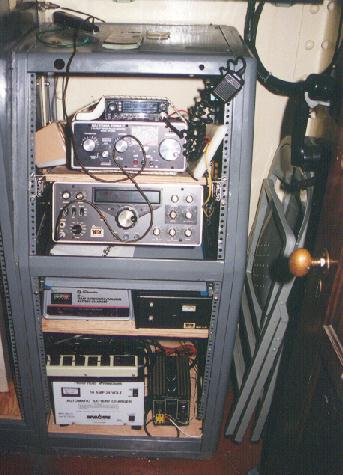Liberty ship was the name given to the EC2-S-C1 type ship designed for "Emergency" construction by the United States Maritime Commission in World War II. Liberty ships were nicknamed "ugly ducklings" by President Franklin Delano Roosevelt.
The first of the 2,751 Liberty ships was the SS Patrick Henry, launched on Sept. 27, 1941, and built to a standardized, mass produced design. The 250,000 parts were pre-fabricated throughout the United States in 250 ton sections and welded together in about 70 days. One Liberty ship, the SS Robert E. Peary was built in four and a half days. Each ship cost just under $2,000,000 to build.
The Liberty was 441 feet long with a beam of 57 feet. Her three cylinder,
triple expansion marine steam engine was fed by two oil burning boilers.
The engine produced 2,500 hp thus propelling the ship at 11 knots. Five
holds could carry over 9,000 tons of cargo, plus airplanes, tanks, and
locomotives could be lashed to the deck. These ships carried
a merchant crew of about 44 and 12 to 25 Naval Armed Guard. The Brown is
only one of two operational Liberty ships left.
During WWII, when a convoy was ready to sail , the Radio Officers on Liberty ships were required to attend a " convoy conference ".with the Master of their ship. Ian Malcom , the third Radio Operator of a Liberty ship , provides the "The instructions to Radio Operators" in his book "Life Aboard a Wartime Liberty Ship".
Office Of The Navy
Port Director
17 Battery Place
New York, N. Y.
Instructions To Radio Operators
1. If ashore and you cannot locate your ship, please phone:
COMMUNICATIONS DUTY OFFICER - Bowling Green 9-6220 Extension 42.
DO NOT MENTION THE NAME OF YOUR SHIP Talk slowly
and distinctly giving your own name only. Officer on duty will be
able to inform you how to make ship. Be patient it will take a
few
minutes. Always use a PHONE IN A BOOTH - Try to have a pencil
ready Use the back of this notice to write on.
2. The Master of your vessel will receive your communication plan.
When he comes aboard, BE SURE TO ASK HIM FOR IT. YOU ARE
TO HAVE THE COMMUNICATION PLAN IN RADIO SHACK
THROUGHOUT THE VOYAGE. IT IS TO BE GIVEN TO MASTER
UPON REACHING DESTINATION.
3. You will have Master instruct all Watch Standers to keep you
informed immediately when:
(a) you are in fog or cannot see Visual Signals from Commodore.
(b) When emergency exists, as in the presence of the enemy.
4. You will obtain from the Master - WIMS III and retain possession
in shack while at sea. [See note 1]
5. Obtain from the Master the latest BAMS (Broadcast to Allied Merchant
Ships)
Lettered and Numbered messages of interest to you. They are marked
TO BE GIVEN TO RADIO OPERATOR and the Master receives them from
the New
York Port Director.
6. The Radio Officer shall survey each private broadcast receiver
aboard
his vessel. Any receiver not listed as approved in WIMS II
Appendix D is to be made inoperative by removing vital parts.
This order applies to receivers owned by ALL SHIPS OFFICERS
as well as CREW. You are responsible to Naval Authorities for the
execution of this order, the Master will support you in this.
7. Keeping Radio Log Conform with instructions in WIMS II Art.45
8. General regulations for testing in U.S. inland waters *was given
your
Master upon arrival in New York. Obtain these regulations from him.
Testing of transmitters between conference time and ships departure
is PROHIBITED unless permission is granted by Port Director as
shown below:
Freq. _________ kcs Time _____________ EWT Approved ___________
9. BE ALERT - SAVE YOUR LIFE AND THE LIVES OF YOUR
SHIPMATES - DON'T TALK - DON'T TALK - THE ENEMY IS LISTENING
[Ed Note 1] WIMS/-I, II, III, Wartime Instructions
for Masters of Merchant Vessels.
A set of standing orders to ships masters traveling in convoy.
Presented here is the radio room of the S.S. John Brown. The room is located on the port side behind the bridge. The free floor space in the room is about 6 feet by 8 feet.


